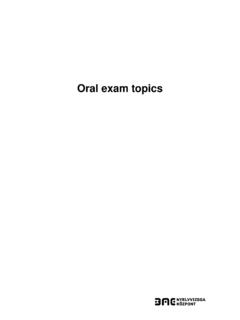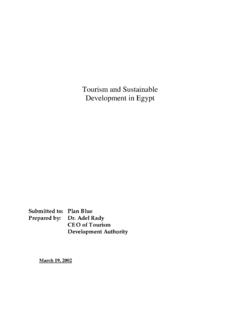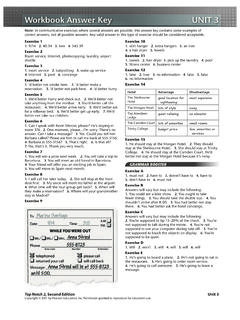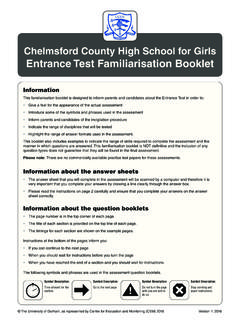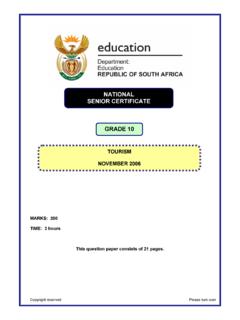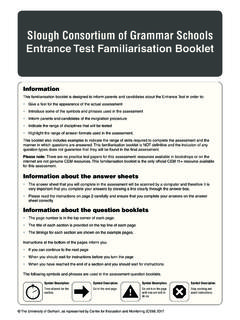Transcription of INDICATORS OF SUSTAINABILITY & SUSTAINABLE …
1 The Macaulay Institute April 2006 White V., McCrum G., Blackstock , and Scott A. The Macaulay Institute Craigiebuckler Aberdeen AB15 8QH INDICATORS OF SUSTAINABILITY & SUSTAINABLE TOURISM: SOME EXAMPLE SETS CONTENTS 1. Introduction 1 2. World Tourism Organisation INDICATORS 2 3. UN Commission on SUSTAINABLE Development- INDICATORS of SUSTAINABLE Development 6 4. OECD INDICATORS of Environmental SUSTAINABILITY 8 5.
2 European Environment Agency 12 6. UK SUSTAINABLE Development INDICATORS 15 7. Spanish System of Environmental Tourism INDICATORS 17 8. English Tourism Council: National SUSTAINABLE Tourism INDICATORS 2002 18 9. Scotland: Meeting the Needs - INDICATORS of SUSTAINABLE Development 19 10. Green Globe 21: The Douglas Shire Community Working Group Experience 20 11.
3 Cairngorms National Park: Park Plan (Proposed) INDICATORS 21 12. Cairngorms National Park: SUSTAINABLE Tourism Strategy 22 13. Conclusion 23 Abbreviations CNPA Cairngorm National Park Authority FT/PT Full-time; part-time SD SUSTAINABLE Development ST SUSTAINABLE Tourism STI SUSTAINABLE Tourism Indicator ViSIT Visitor Service, Information and Tourism This work was part of a SEERAD funded project on SUSTAINABLE Rural Development (RO203909). The authors would like to acknowledge the input by Cairngorm National Park Authority staff and members of the ViSIT forum during the life of this project.
4 "Any use which a third party makes of this document, or any reliance upon it, or decisions to be made based upon it, are the responsibility of such a third party. The Macaulay Institute accepts no duty of care or liability whatsoever to any such third party, and no responsibility for damages, if any, suffered by any third party as a result of decisions or actions taken or not taken on the basis of the contents of this document." 11 Introduction The Cairngorms National Park has been awarded the European Charter for SUSTAINABLE Tourism in Protected Areas and the CNPA is currently working towards adopting and applying a set of INDICATORS . In support of this work, the Macaulay Institute has provided the CNPA with a report that provides a suggested approach to selecting and implementing INDICATORS of SUSTAINABLE tourism (see A Framework for Developing INDICATORS of SUSTAINABLE Tourism ).
5 The project aimed to support the CNPA and their ViSIT forum by providing a structure for thinking through the process of selecting INDICATORS that encouraged transparency and deliberation by asking provocative questions, rather than providing answers . This document provides some example sets of indictors that may be usefully considered by the CNPA and the ViSIT forum. It consists of tables of existing INDICATORS sets that may be appropriate for adoption or adaptation for the Cairngorms National Park. It is one of three supplementary documents to the Framework report. The others are: INDICATORS and SUSTAINABLE Tourism: Interview Findings. INDICATORS and SUSTAINABLE Tourism: Literature Review. 22 World Tourism Organisation (WTO) INDICATORS Source: World Tourism Organisation (2005) INDICATORS of SUSTAINABLE Development for Tourism Destinations: A Guidebook available to buy through: The WTO has developed baseline, universal , tourism INDICATORS (shown below) that can be applied to all tourism destinations.
6 More tailored indicator sets are presented over the page. Baseline Issues and Baseline INDICATORS Baseline Issue Suggested Baseline Indicator(s) Local satisfaction with tourism Local satisfaction level with tourism (Questionnaire) Effects of tourism on communities Ration of tourists to locals (average & peak period/days) % who believes that tourism has helped bring new services or infrastructure (questionnaire-based) Number & capacity of social services available to the community (% which are attributed to tourism) Sustaining tourist satisfaction Level of satisfaction by visitors (questionnaire-based) Perception of value for money (questionnaire-based) Percentage of return visitors Tourism seasonality Tourist arrivals by month or quarter (distribution throughout the year)
7 Occupancy rates for licensed (official) accommodation by month (peak periods relative to low season) and % of all occupancy in peak quarter or month) % of business establishments open all year Number and % of tourism industry jobs which are permanent or full-year (compared to temporary jobs) Economic benefits of tourism Number of local people (& ratio men to women) employed in tourism (also ratio of tourism employment to total employment) Revenues generated by tourism as % of total revenues generated in the community Energy management Per capita consumption of energy from all sources (overall, and by tourist sector- per person day) % businesses participating in energy conservation programs, or applying energy saving policy and techniques % of energy consumption from renewable resources (at destinations, establishments) Water availability & conservation Water use (total volume consumed and litres per tourist per day) Water saving (% reduced, recaptured or recycled) Drinking water quality % of tourism establishments with water treated to international potable standards Frequency of water-borne diseases.
8 Number/ % of visitors reporting water-borne illnesses during their stay Sewage treatment (waste water management) % of sewage from site receiving treatment (to primary, secondary, tertiary levels) % of tourism establishments (or accommodation) on treatment system(s) Solid waste management Waste volume produced by the destination (tonnes) by month Volume of waste recycled (m3) / Total volume of waste (m3) (specify by different types) Quantity of waste strewn in public areas (litter counts) Development control Existence of a land use or development planning process, including tourism % of area subject to control (density, design, etc) Controlling use intensity Total number of tourist arrivals Number of tourists per square metre of the site ( at attractions), per square kilometre of the destination, - mean number/peak period average Destination Applications The WTO has suggested INDICATORS for specific destination areas.
9 Included here are the suggestions which could be relevant to the Cairngorms National Park: Parks and Protected Area ; Communities within or adjacent to Protected Areas ; and Natural and Sensitive Ecological Sites . (Italic indicates a Baseline Indicator ) Destination: Parks & Protected Areas Suggested INDICATORS Issues INDICATORS Visitor numbers Total number of visitors to the Park and to key sites Peak numbers (peak day, month) Length of stay Use intensity on key sites (persons per km2) Revenue from paid visitors Number of guides/operators permitted to use park % of all visitors who are in controlled/guided visits Integrity of key protected systems Number of sites/ecosystems/assets considered to be damaged or threatened (% of all defined systems/assets in protected area)
10 INDICATORS of health related to key plant & animal species % of park hardened for visitor or other use % of protected area subject to different levels of control Damage attributable to visitor activity % of protected system in degraded condition (where possible classified due to cause) % trails & routes (length) in damaged condition Cost of repair to damaged systems (annually) % of park area affected by unauthorised activities (hunting, tree cutting, poaching etc) Number of incidents of poaching identified Level of visitor control and monitoring Number of human/animal contacts reported involving injury or risk of injury Number of crimes against tourists Number of incidents of vandalism % visitors who do not pay for entry (where entry fee is charged) Number of wardens or control staff (and number per tourist) Marketing Amount spent on marketing the protected area Management Number of park officials (wardens, managers, maintenance etc) Number of enforcement personnel per visitor Cost of protection Number of public/community meetings held with stakeholders including local periphery communities Ratio of revenues to costs for Park operations Destination.


